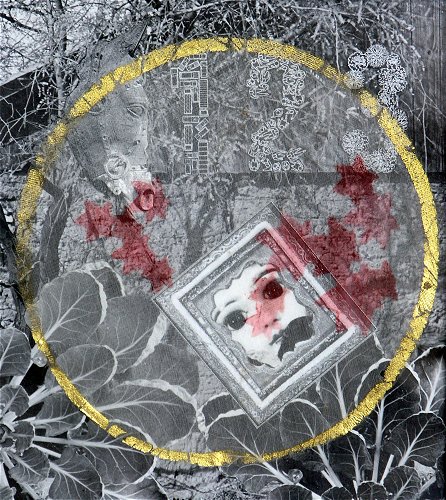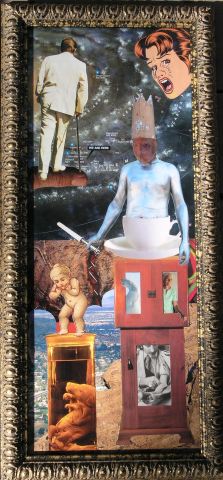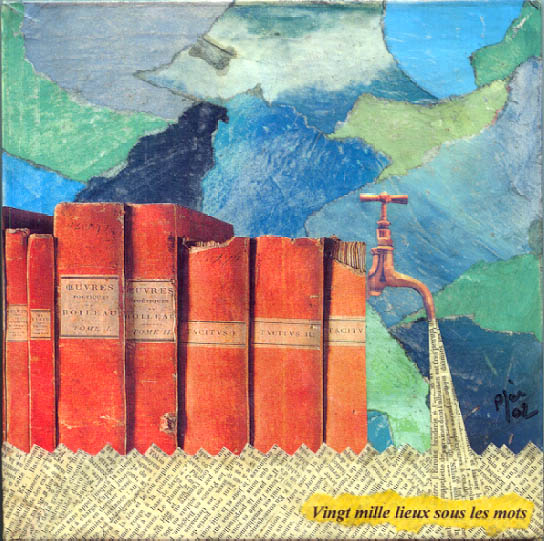OM.2012.206 - Pascale Hulin - France - collage with found materials and thread
An Exhibition from the International Museum of Collage, Assemblage and Construction commemorating 100 years of Collage Art
Followers
Saturday, August 18, 2012
383-386 - Bill DiMichele - USA
OM.2011.223-226 - Bill DiMichele - USA - Netherworld 1 through 4 - collage
Collage Statement:
Collage plugs us into the world beyond the world, a cut-up/arrangement of surfaces that point to the magical, the frightening universe of Surrealism. From the ink writers of Japan to Picasso, to Britain's Richard Hamilton, to Max Ernst, collage has been a way through the door of Surrealism, toward the space of the fantastic. This is where we find ourselves, at the doorstep of the interstellar, at the ladder of the mind. And this space cannot be tarnished, cannot be ruined, because it belongs to and only to those who use it.
374-382 - Christian Heinrich - Germany
OM.2012.181 - Christian Heinrich - Germany
OM.2012.182 - Christian Heinrich - Germany
OM.2012.183 - Christian Heinrich - Germany
OM.2012.184 - Christian Heinrich - Germany
OM.2012.185 - Christian Heinrich - Germany
OM.2012.186 - Christian Heinrich - Germany
OM.2012.187 - Christian Heinrich - Germany
OM.2012.188 - Christian Heinrich - Germany
OM.2012.189 - Christian Heinrich - Germany
collages from prepared papers
http://www.christian-heinrich.com/
collages from prepared papers
http://www.christian-heinrich.com/
My works of art are always connected with memories. A manifold puzzle of experienced pictures gradually joined to become a whole. The result is a specific mood, a compression of sensuous experienced moments. Each work of art has its own story; it’s filled with emotional energy, a reflection of the inner design of my thoughts, emotions, expectations, hopes, experiences, dreams and fantasies. Later with adequate distance to the art work am I able to interpret the emotional and physical frame of mind I was in. During the working process I put myself in a meditative trance. I choose the appropriate corresponding music to the respective theme, reviving the atmosphere experienced which comes to life. Doing so only allows a limited perception of my surroundings. For the viewer of my work there remains a,”let themselves be transmitted”, sense there own feelings and thoughts going on a journey of imagination and creativity. My personal handwriting is visible in all my art work. That is why I sign the back. Standout signatures are a sign of vanity. The art work no longer has the task to depict a real existing observation, a copy of nature. I attempt to find my own context, abstract forms, looking for symbols that can free the original thoughts and feelings within us. The use of abstraction is a bridge that frees me from my accustomed optical structures. It is a means to the end, an opportunity to concretize my inner images. The argument with abstraction corresponds with the quest for things that can’t be grasped, with the realization to make them graspable. That what is to be painted, is that, what no longer exist to be painted. To portray that “no longer” means finding corresponding abstract forms. Change lies in everything, movement and transitory. In everything there is the joining of contrasting nature and suspense. Everything is in movement. Only when I’m able to begin a process of destruction have I freed myself from cherished things and discover by chance the “concretion”. Talent and aptitude aren’t the sole requirement to be artistically active. It demands a long quest and productive studies. Most of all art is the urge for creativity, the scanning of a huge field, the composition, the destruction and finally the healing. With art we permit ourselves to follow new paths, developing, moulding and probing the world, coaxing up her deepest secrets. The difficulty lies in the reduction of the means. During the course of time one lives through diverse phrases and preferences. One time its certain colours or material, in addition at other times its new technical skills or tools. Then the change itself of the themes, the forms, the essence, and never the less as a personal handwriting being drawn like a red line through all the years of transformation. With the acquisition of more experience and craftsman’s skills the art works gain more and more depth, become more intensive, powerful and lively. My first collages came to being in 1980 while studying at the University of Art Berlin (Hochschule der Künste). In the beginning the montages were rather simple. I cut pictures out of the magazines Geo and Stern that I joined together like a puzzle, which I later over painted with oil paint. With regard to content, the pictures were mostly of political nature devoted particularly to the environment problematic of the 1980es and German post war history. In the years 1986 – 1990 I occupied myself intensively with Greek Mythology. I created countless works to the theme Deadalus and Ikarus. The contents of the myth became a key experience for me. In everything we humans do lay the urge and the danger to cross unknown boundaries. Only the wise notice the tightrope he is on. He strides very carefully, cautiously forward and respects his own boundaries. I travelled to Turkey the first time in 1987 and was deeply touched by the hospitality of the people, the sensitive music and ancient temple grounds with the feeling of time they’ve witnessed. Impressed with the admiration and respect for the founder of the modern republic, Mustafa Kemal Atatürk, whose portrait I came across again and again, I created a critical reflecting series of collages with worked in photoes. But also the radiation emitted from the mighty mosques and the ruins of the ancient seaport of Ephesus didn’t leave me untouched. Especially the statue of the fertility goddess Artemis exerted such fascination that in addition I also did a series of collagen created on a blue base and white sand background. Henceforth from 1990 onwards I’ve chosen the term “Oil Collage” for my technique. In 1995 I travelled to the USA, to California and New York. The world open city of New York suddenly opened me completely new techniques and formal perspectives. In a small shop on Broadway, Kate’s Papers, I found hand-made paper from South America and Asia for the first time. Fascinated from its consistency, its structure and texture the first collages on hand-made paper came into being, in which I expressed my love for the city. Since then I’m like a small child always on the quest for new uncommon paper from far away countries from around the world. There are so many different types of paper. In 1998 I travelled through the Southwest of the USA, Nevada, Arizona, Colorado and California. How can I capture in my art works these endless distances that I never experienced in Europe? Everything was so wide and monumental. We travelled for hundreds of miles and the countryside was always changing, across deserts, through canyons, over snow covered mountains and past never ending fields. Now I understood how a landscape can draw an artist into its spell, which fascination the perspective performs, how the play of the distance and the horizon would no longer let me go. In the year 2000 I discovered South Africa, a country that even today surprises and fascinates me from anew. Here I sense my roots and feel at home. In 2002 I went to Cape Town for three months working and teaching at the Ruth Prowse Art School in Woodstock. In that for this continent typical light I created very cheerful, shiningly colourful art works on wood out of hand-made paper. Also the structures obtained through the working process with typical African papers, made from elephant dung or bananas, were even more emphasized by the rich textures. How can I capture, in my art works, this extreme bright light that is very clear one time and at another appears milky? How can I portray the expression, the mood of the landscape without becoming representational? Again everything here is wide but not monumental. Everything here is slightly more graceful and playful. The countryside here is formed by the animals and the people. |
374 - RANDY BURMAN - USA
OM.2012.205 - Randy Burman - Tribute to Rene Magritte - 8.25” x 8.375” x 3.5 - 2010
Repurposed wood box, gold frame corner, wood, hand-brushed sheet metal and model steam train engine
This work unapologetically uses interpreted elements of Magritte's iconic Time Transfixed. In explaining Time Transfixed, Magritte said: "I decided to paint the image of a locomotive . . . In order for its mystery to be evoked, another immediately familiar image without mystery — the image of a dining room fireplace — was joined." It is in the surprising juxtaposition and scale shift of these common and unrelated images that their mystery and magic arises. Magritte transformed the pipe of a coal-burning stove into a charging locomotive, situating the train in a fireplace vent so that it appears to be emerging from a railway tunnel. The tiny engine races out into the stillness of a sparsely furnished dining room, its smoke neatly floating up the chimney, suggesting in turn the smoke of coal in the stove. TRIBUTE TO RENE MAGRITTE was part of the Small Works exhibition at Artformz collective.
Statement
To say my assemblages are spontaneously created would be an understatement. The mysterious process of creation is the closest thing I can think of to magic. In the studio I am surrounded by a mountain of collected objects, some bought, some found. Although my hands and brain play a part in the selection process, I practically just watch them, as they pair themselves together to become a poetic dialogue of combined and juxtaposed and often banal objects. I most often don’t begin with a fixed outcome in mind. Yet, as the various parts join together, they appear to suggest philosophical concepts that are more than the sum of their parts. There is a lot of trial and error – I’ll hold up one object next to another, try different arrangements, and at some point, like a bolt of lightning, the “AHA!” moment strikes where I intuitively understand that, “this is it”.
For all the spontaneity and mixing together of objects, my aesthetic is based on a dominant reductionist theory. If I could reduce the developing concept to a single dot, I would. In fact, if I could eliminate the dot, I’d be even happier. Part of my process is certainly informed by my many years as a graphic designer and particularly my technique in designing logos, where I would start with a group of concepts and distill them down to the most minimalist graphic form to convey a clear message or identity.
An art observer describing my art practice said: “Burman is an irreverent social commenter and mirthful provocateur who creates assemblages which provide an environment to examine and question the integrity of human nature.” Don’t know that I could have articulated it any better, or even as well. Wish I had said that. I define my practice as focused on philosophical concerns and social issues that convey my observations on life, the human condition and our search for meaning. It’s my intention to create works that express metaphysical narratives and that hopefully reach profoundly into our psyches to address our deepest yearnings, frustrations, and beliefs.
Friday, August 17, 2012
365 - 372 - Thiago Mazucato - Brazil
OM.2012.194 - Thiago Mazucato - Brazil - Subtly - collage on paper - 2012
OM.2012.195 - Thiago Mazucato - Brazil - Noise - collage on paper - 2012
OM.2012.196 - Thiago Mazucato - Brazil - Not by Chance - collage on paper - 2012
OM.2012.197 - Thiago Mazucato - Brazil - The End of All - collage on paper - 2012
OM.2012.199 - Thiago Mazucato - Brazil - Clash - collage on paper - 2012
OM.2012.200 - Thiago Mazucato - Brazil - Trash - collage on paper - 2012
OM.2012.201 - Thiago Mazucato - Brazil - Time - collage on paper - 2012
362-4 - Laila Manieri - Brazil
om.2012.191 - Laila Manieri - Brazil - 1500 - collage on paper - 2012
om.2012.192 - Laila Manieri - Brazil - Ideias - collage on paper - 2012
om.2012.193 - Laila Manieri - Brazil - Vícios de Vinícius - collage on paper - 2012
Thursday, August 16, 2012
361 - Ruth Terrill - USA

OM.2000.049 - Ruth Terrill - Keeping the Focus - 2000 - Collage - Donated by the Artist
Tuesday, August 14, 2012
Sunday, August 12, 2012
359 - Zach Touchon - USA
OM.2012.179 - Zach Touchon - USA - mixed media collage on paper - 12x12 inches
Wednesday, August 8, 2012
Tuesday, August 7, 2012
Sunday, August 5, 2012
353 - Luc Fierens - Belgium
OM.2011.082 - Luc Fierens (BELGIUM) Collage Centennial
Title: Island - collage on paper - gift of the artist
aslo included postfluxpostbooklet #97 and several artist postcards
aslo included postfluxpostbooklet #97 and several artist postcards
Artist Statement
Originally I was a poet who wrote experimental verses influenced by the Belgian avant-garde - in particular Van Ostayen and I turned to visual poetry very quickly. Nowadays, since the late 90's, I have focused on my re-poesia visiva. This movement of Italian visual poetry was/is known to be sharp, political and anti-pop because of its semiological guerilla (E.Miccini). I don't think this view is old-fashioned or passé or déjà vu but CONTEMPORARY. Because most political events now have a striking resemblance with the 60's. Protest, social changes , crisis (also 80's), powerful mass media, only the names of the multinationals changed but the rich are richer and the poor are poorer in reality. So a poet must try to change the world - or at least his own piece of it. This utopian view is part of my way of seeing/making art as a collagist provocateur. Visual poetry goes beyond collage. Collage has been recuperated through/like "rubberstamping,mailed art and scrapbooking" So re-poesia visiva is a tool/way of art/life to attack reality. In my visual poems I use the written word. The word questions the images and makes layers visible: of signs to be read or seen.
web: http://www.vansebroeck.be
351+352 - Keith Pace - USA
[352] OM.2012.030 - Keith Pace - collage on paper
"B - 16" is a Keith Buchholz piece I got in an exchange a while ago. I added the Pope (it really needed him). I call it B - 16 (in Bingo 16 is in the "I" column). For Benedict XVI I could have used "B - XVI", but I wanted a stronger link to the game.
[352] OM.2012.030 - Keith Pace - USA
"Dangerous Animals" is a new piece. I am primarily using my own photographs in most of my current photomontage work. I think most people will find a connection between a rhino and an automatic firearm.
Saturday, August 4, 2012
344 - Katie Gutierrez - USA
[344] OM.2008.022 - Katie Gutierrez - USA - ‘The Divide’ - collage and encaustic on paper - 9x12 inches
343 - Pierre-Jean Varet - France
Subscribe to:
Posts (Atom)

















































